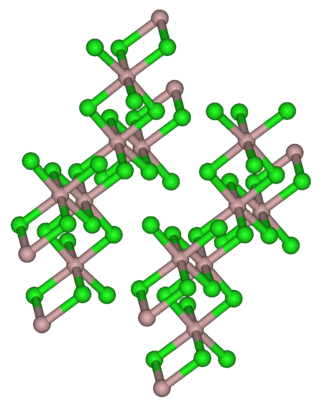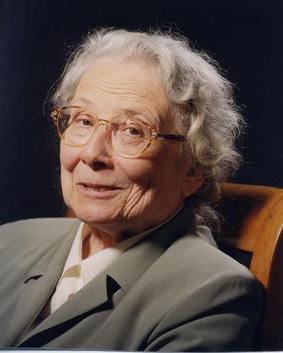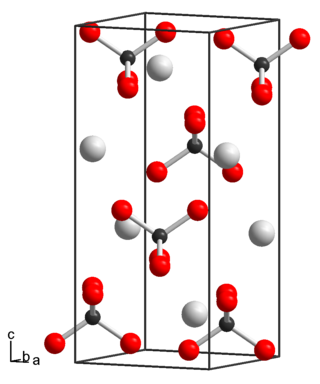Related Research Articles

Indium(III) bromide, (indium tribromide), InBr3, is a chemical compound of indium and bromine. It is a Lewis acid and has been used in organic synthesis.

Niobium oxychloride is the inorganic compound with the formula NbOCl3. It is a white, crystalline, diamagnetic solid. It is often found as an impurity in samples of niobium pentachloride, a common reagent in niobium chemistry.
In chemistry, mercury nitrides are chemical compounds that contain mercury cations and nitride anions. Binary mercury nitrides, e.g. Hg3N2, are not well characterized and are probably unstable in the condensed phase under ordinary conditions. A nitride of mercury has been reported in the form of [Hg2N](NO3). This reddish solid adopts a network structure consisting of NHg4 tetrahedra linked by nitrate ligands.
The nitridoborates are chemical compounds of boron and nitrogen with metals. These compounds are typically produced at high temperature by reacting hexagonal boron nitride with metal nitrides or by metathesis reactions involving nitridoborates. A wide range of these compounds have been made involving lithium, alkaline earth metals and lanthanides, and their structures determined using crystallographic techniques such as X-ray crystallography. Structurally one of their interesting features is the presence of polyatomic anions of boron and nitrogen where the geometry and the B–N bond length have been interpreted in terms of π-bonding.

Margot Becke-Goehring was a Professor of Inorganic Chemistry at the University of Heidelberg and she was the first female rector of a university in West Germany - the Heidelberg University. She was also the director of the Gmelin Institute of Inorganic Chemistry of the Max Planck Society that edited the Gmelins Handbuch der anorganischen Chemie. She studied Chemistry in Halle (Saale) and Munich, and she finished her doctorate and habilitation at the University of Halle. For her research on the chemistry of main-group elements, she was awarded Alfred Stock Memorial Prize. One of her most notable contributions to inorganic chemistry was her work on the synthesis and structure of poly(sulfur nitride), which was later discovered to be the first non-metallic superconductor. For her success in editing the Gmelins Handbuch der anorganischen Chemie, she received the Gmelin-Beilstein memorial coin.
The phosphidosilicates or phosphosilicides are inorganic compounds containing silicon bonded to phosphorus and one or more other kinds of elements. In the phosphosilicates each silicon atom is surrounded by four phosphorus atoms in a tetrahedron. The triphosphosilicates have a SiP3 unit, that can be a planar triangle like carbonate CO3. The phosphorus atoms can be shared to form different patterns e.g. [Si2P6]10− which forms pairs, and [Si3P7]3− which contains two-dimensional double layer sheets. [SiP4]8− with isolated tetrahedra, and [SiP2]2− with a three dimensional network with shared tetrahedron corners. SiP clusters can be joined, not only by sharing a P atom, but also by way of a P-P bond. This does not happen with nitridosilicates or plain silicates.
Wilhelm Karl Klemm was an inorganic and physical chemist. Klemm did extensive work on intermetallic compounds, rare earth metals, transition elements and compounds involving oxygen and fluorine. He and Heinrich Bommer were the first to isolate elemental erbium (1934) and ytterbium (1936). Klemm refined Eduard Zintl's ideas about the structure of intermetallic compounds and their connections to develop the Zintl-Klemm concept.
Hartmut Bärnighausen is a German chemist and crystallographer. He is known for establishing the Bärnighausen trees which describe group-subgroup relationships of crystal structures.
Hans Georg von Schnering was a German chemist and professor of inorganic chemistry at the University of Münster, honorary professor at the University of Stuttgart and director at the Max Planck Institute for Solid State Research.
The inorganic imides are compounds containing an ion composed of nitrogen bonded to hydrogen with formula HN2−. Organic imides have the NH group, and two single or one double covalent bond to other atoms. The imides are related to the inorganic amides (H2N−), the nitrides (N3−) and the nitridohydrides (N3−•H−).
The telluride phosphides are a class of mixed anion compounds containing both telluride and phosphide ions. The phosphidotelluride or telluridophosphide compounds have a [TeP]3− group in which the tellurium atom has a bond to the phosphorus atom. A formal charge of −2 is on the phosphorus and −1 on the tellurium. There is no binary compound of tellurium and phosphorus. Not many telluride phosphides are known, but they have been discovered for noble metals, actinides, and group 4 elements.
The telluride iodides are chemical compounds that contain both telluride ions (Te2−) and iodide ions (I−). They are in the class of mixed anion compounds or chalcogenide halides.
A selenite fluoride is a chemical compound or salt that contains fluoride and selenite anions. These are mixed anion compounds. Some have third anions, including nitrate, molybdate, oxalate, selenate, silicate and tellurate.
A chloride nitride is a mixed anion compound containing both chloride (Cl−) and nitride ions (N3−). Another name is metallochloronitrides. They are a subclass of halide nitrides or pnictide halides.
Phosphanides are chemicals containing the [PH2]− anion. This is also known as the phosphino anion or phosphido ligand. The IUPAC name can also be dihydridophosphate(1−).
Arsenidogermanates are chemical compounds that contain anions with arsenic bonded to germanium. They are in the category of tetrelarsenides, pnictidogermanates, or tetrelpnictides.
Carbide chlorides are mixed anion compounds containing chloride anions and anions consisting entirely of carbon. In these compounds there is no bond between chlorine and carbon. But there is a bond between a metal and carbon. Many of these compounds are cluster compounds, in which metal atoms encase a carbon core, with chlorine atoms surrounding the cluster. The chlorine may be shared between clusters to form polymers or layers. Most carbon chloride compounds contain rare earth elements. Some are known from group 4 elements. The hexatungsten carbon cluster can be oxidised and reduced, and so have different numbers of chlorine atoms included.
Carbide bromides are mixed anion compounds containing bromide and carbide anions. Many carbide bromides are cluster compounds, containing on, two or more carbon atoms in a core, surrounded by a layer of metal atoms, encased in a shell of bromide ions. These ions may be shared between clusters to form chains, double chains or layers.
Carbide iodides are mixed anion compounds containing iodide and carbide anions. Many carbide iodides are cluster compounds, containing one, two or more carbon atoms in a core, surrounded by a layer of metal atoms, encased in a shell of iodide ions. These ions may be shared between clusters to form chains, double chains or layers.

Potassium perrhenate is an inorganic compound with the chemical formula KReO4.
References
- 1 2 3 4 5 6 7 8 9 ""Brauer, Georg Karl", in: Hessische Biografie (Stand: 9.10.2017)". www.lagis-hessen.de. Retrieved 2018-12-29.
- ↑ "Elisabeth Ostwald". www.wilhelm-ostwald.de. Retrieved 2018-12-29.
- ↑ Werner, Helmut (2016-11-07). Geschichte der anorganischen Chemie: Die Entwicklung einer Wissenschaft in Deutschland von Döbereiner bis heute. Weinheim. ISBN 9783527339075. OCLC 962751045.
- 1 2 3 4 "Brauer Georg Karl - Detailseite - LEO-BW". www.leo-bw.de. Retrieved 2018-12-29.
- ↑ Zintl, E.; Brauer, G. (1933). "Über die Valenzelektronenregel und die Atomradien unedler Metalle in Legierungen". Zeitschrift für Physikalische Chemie. 20B (1): 245–271. doi:10.1515/zpch-1933-2023. ISSN 0942-9352. S2CID 100136558.
- ↑ Brauer, Georg (1941). "Die Oxyde des Niobs". Zeitschrift für Anorganische und Allgemeine Chemie (in German). 248 (1): 1–31. doi:10.1002/zaac.19412480101. ISSN 1521-3749.
- ↑ Brauer, Georg; Jander, Jochen (1952). "Die Nitride des Niobs". Zeitschrift für Anorganische und Allgemeine Chemie (in German). 270 (1–4): 160–178. doi:10.1002/zaac.19522700114. ISSN 1521-3749.
- ↑ Brauer, G.; Gradinger, H. (1954). "Über heterotype Mischphasen bei Seltenerdoxyden. II. Die Oxydsysteme des Cers und des Praseodyms". Zeitschrift für Anorganische und Allgemeine Chemie (in German). 277 (1–2): 89–95. doi:10.1002/zaac.19542770110. ISSN 1521-3749.
- ↑ Zintl, E; Brauer, Georg (February 1935). "Konstitution des Lithiumnitrids". Zeitschrift für Elektrochemie und Angewandte Physikalische Chemie. 41 (2): 102–107. doi:10.1002/bbpc.19350410209. S2CID 93010836.
- ↑ Brauer, Georg (1963). Handbook of Preparative Inorganic Chemistry V1 (2nd ed.). Burlington: Elsevier Science. ISBN 9780323161275. OCLC 843200092.
- ↑ Brauer, Georg (1965). Handbook of Preparative Inorganic Chemistry V2 (2nd ed.). Burlington: Elsevier Science. ISBN 9780323161299. OCLC 843200097.
- ↑ Hrsg. von Georg Brauer unter Mitarbeit von Marianne Baudler (1975). Handbuch der präparativen anorganischen Chemie / 1 (3., umgearb. Aufl ed.). Stuttgart: Enke. ISBN 978-3432023281. OCLC 310719485.